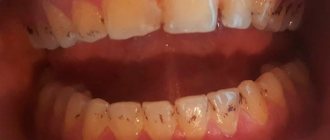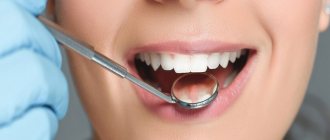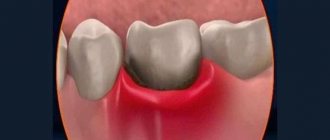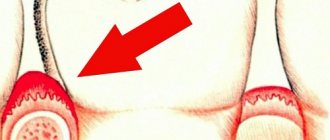Publication date: 01/25/2021
Every person's teeth are designed to last for many years. They have several levels of protection:
- Enamel is a highly durable mineralized tissue that protects the surface of the tooth.
- Dentin is a less hard tissue, but also strong. The main task of dentin is to protect the pulp - the inner tissue. It is the nerve endings in the pulp that signal us about the problem. If the surface layers are broken, we experience pain.
- Cement - covers the roots, protecting them from adverse influences
Overcoming these layers of defense is not easy, but it is possible. And then the teeth rot.
Causes of rotting
In the first place is fear. It is the irrational fear of the dentist, which is difficult to control, that makes us put off visiting the doctor. Often to the point where it is no longer possible to save the tooth. No matter what facts they give us, no matter how much we persuade ourselves, phobias do not lend themselves to rational arguments.
But this is far from the only reason.
General diseases
Our body is a single system. Discord in one place leads to problems in another. Thus, diseases of the gastrointestinal tract cause dental problems.
Infections, fungal diseases, even hormonal imbalances often lead to inflammatory processes in the mouth.
Ecological problems
In regions where drinking water is of poor quality, dental problems are 3-4 times more common. The same picture is observed where there are large industrial enterprises. Increased amounts of toxic microelements in the environment harm overall health and negatively affect teeth.
Diet
There are foods that provoke the growth of bacteria in the oral cavity, which means they contribute to tooth decay. Yes, that same sugar, but not only that. Acids formed during the fermentation of carbohydrates are the main enemies of enamel.
Lifestyle
Addictions of any kind are not good for dental health. Cigarettes, drugs, alcohol are a direct path to problems.
This also includes restrictive diets. Vegetarians, vegans, and Keto fans need to carefully ensure that the body receives all trace elements and vitamins.
Oral diseases
Inflammatory processes in the mouth are a haven for bacteria. Therefore, it is important to regularly carry out sanitation and ultrasonic cleaning of teeth. Periodontal disease, periodontitis, stomatitis, gingevitis, cheilitis require special treatment, which is better not to delay.
Oral hygiene
This is perhaps the easiest way to destroy teeth. All that’s left to do is brush and floss twice a day. 90% of the population does this, but not as carefully as we would like. There are special teeth cleaning schemes. They involve treating surfaces from all sides and for a certain time. Unfortunately, now
90% are those who brush their teeth for less than 1 minute.
Genetic predisposition
Alas, often all preventive measures are not able to help keep teeth safe and sound. Healthy, strong teeth, just like bad ones, are inherited.
Diagnosis of root caries
During a visual examination, dental root caries can be detected only in 13% of cases. If this disease is suspected, additional examination methods are prescribed:
- Probing. The doctor inserts an instrument with a curved tip under the gum and examines the structure of the tooth root, assessing its integrity. During such a study, it is possible to identify chips, roughness, and irregularities that indicate the development of pathology.
- Radiography. The dentist orders an x-ray of one tooth or the entire jaw. The images show the localization of the pathological area with an accuracy of up to a millimeter. In addition, radiography allows you to assess the condition of neighboring teeth and identify hidden inflammatory processes.
- Thermal diagnostics. The study is carried out using a directed stream of water, which is used to treat the tooth from different sides. After such a procedure, it is possible to determine which areas of the root are susceptible to carious lesions.
- Electroodontometry is a diagnostic of pulp viability, allowing you to find out whether the nerve is damaged and how deep the inflammation has penetrated.
- Visiography. Using a special device called a visiograph, the dentist scans the tooth in different projections. He can then view the root from different angles on a computer.
Before treating the root of a tooth, the dentist suggests the patient undergo ultrasonic cleaning to clean the enamel of plaque. Tartar may obstruct your view during the procedure. Based on the results of the examination, the doctor determines whether the tooth can be saved or whether it needs to be removed.
Online consultation with a doctor
If you are concerned about the condition of your teeth and the symptoms described in this article: putrid odor, pain when biting, sensitivity of the enamel to cold, hot, sour, sweet, dark holes on the tooth, then it is best to undergo an examination and consultation with a dentist. Because these may be symptoms of deep caries, cysts, and other diseases. Bacteria or infection, entering the blood or lymph, affect healthy tissues, causing complications and illnesses. Which, if neglected, will lead to more expensive treatment:
- depulpation;
- dental restoration;
- deletion;
- dental implantation;
- prosthetics;
- treatment of adentia.
Implantation is a solution for advanced cases
Alas, if the root of a tooth has rotted, then the only solution is removal. But even here, dentists offer a method that will help restore a rotten tooth - implantation. The implant will stop bone loss, prevent loosening and tilting of neighboring teeth, and restore your smile. The immediate loading method involves placing an implant immediately after tooth extraction. There is no need to wait for the hole to heal and you can chew almost immediately.
Stages of decay development
There is no acute form of caries, so small changes are difficult to notice, they accumulate - and now a person cannot smile, only stumps of teeth remain. Therefore, it is important to undergo preventive examinations regularly. The dentist can identify the problem at the initial stage and can easily fix it.
- Rotting begins at the spot stage. The color of part of the surface changes. Enamel demineralization begins. At this stage, treatment is quick and easy.
- The superficial process of demineralization is increasing, but the pain syndrome has not yet manifested itself. The tooth can react to sweet, sour, cold, hot.
- Middle stage The lesion reaches the enamel-dentin junction. Painful sensations occur periodically. Large areas are affected.
- Deep damage The decay process affects the dentin surrounding the pulp. If this process is left unattended, pulpitis will develop. And this is far from the only problem.
Why treat baby teeth?
Rotten baby teeth do not always attract the attention of parents. Especially if the pathological processes are painless and do not bother the child. Adults think that when the bite changes, the bad teeth will disappear by themselves, and instead of rotten teeth, normal molars will grow. Dentists warn about the fallacy of such a misconception.
Rotten milk teeth are:
- damage or destruction of tooth germs - a high risk that the root units will grow sick or not appear at all;
- early loss of primary occlusion units - leads to displacement of existing teeth, the appearance of crowding, and the formation of a pathologically abnormal bite;
- an ugly smile, an unaesthetic appearance - the appearance of complexes due to appearance in young children, decreased contact with peers, uncertainty, isolation;
- deterioration of diction - rotten, breaking teeth interfere with the correct movements of the tongue during speech, leading to a lisp, burr;
- gradual spread of infection - damage not only to the surface of the teeth, but also to the pulp, development of pulpitis, the appearance of an abscess, as well as a tendency to ENT diseases and gastrointestinal diseases.
Complications
Bad teeth are a direct path to a heart attack
. When the tooth's protection is destroyed, bacteria enter directly into the bloodstream. There they can provoke the development of blood clots, inflammation of blood vessels, and this leads to the development of coronary artery disease, which is not far from a heart attack.
Gastrointestinal problems
Rotten teeth make it difficult to chew food well. Not only do poorly chewed pieces irritate the mucous membrane, pathogenic flora from damaged teeth enters the stomach and intestines, where they can multiply uncontrollably, causing diseases such as gastritis, pancreatitis, stomach ulcers and duodenal ulcers. Competent gastroenterologists always advise visiting a dentist.
Diseases of the throat and nose
A constant source of infection in the mouth means that any malfunction in the body will cause a relapse of diseases such as sore throat and sinusitis. Purulent infections are dangerous because they can lead to blood poisoning. And such diseases are difficult, often causing complications. Inflammation of the tonsils often causes rheumatism and heart problems. Those who struggle with chronic sinusitis need to especially carefully monitor the condition of the oral cavity. Chronic manifestations will not go away if there are rotten teeth in the mouth.
And the head too
An advanced inflammatory process can spread to the trigeminal nerve. It is closely connected with the brain, and this is a serious matter. Chronic migraines, memory problems, even Alzheimer's disease are associated with oral health. Although there is no direct evidence that Alzheimer's is caused by the same bacteria that cause inflammation in the mouth, it is better to be on the safe side.
Abscesses and cellulitis are also the result of bacterial inflammation.
Features of the disease during pregnancy
The full development of babies in the womb requires a lot of vitamins and minerals. A complete restructuring occurs in the body, a woman needs to monitor her lifestyle and diet. Ideally, it is necessary to consult a dentist and eliminate the pathology before conceiving a child.
The danger of a purulent process during pregnancy is very great for both the mother and the fetus. Since many medications are prohibited at this time, the second trimester is considered a favorable period for dental procedures. You should visit a doctor immediately when the first signs appear.
Treatment of rotten teeth
What to do when the process of tooth decay begins
Modern dentistry is not about pain at all. This is about caring for the patient and the desire to preserve his teeth.
Dentists' advice is simple, but how many people follow it?
How to prevent teeth from rotting:
- Lead a healthy lifestyle
- Takes good care of your teeth
- Carry out hygiene procedures regularly
- Monitor your general health
Plaque on teeth is the beginning of the decay process. Regular cleaning of tartar is one way to keep your teeth healthy.
Why do teeth rot at the gums?
Caries near the gums and on visible parts of the tooth are no different.
The reasons for its occurrence are the same, but near the gums it is more difficult to identify and treat the disease. Therefore, patients usually consult a doctor at the stage of progressive pulpitis. Timely detection helps prevent the development of caries in the gingival region. To do this, you need to periodically visit the dentist, who will correctly assess the condition of the enamel and detect the development of caries in time. Experts call gum disease a common cause of its occurrence. Food debris that accumulates in the gum pocket promotes the development of bacteria. In addition, the disease can be caused by an incorrectly installed crown, poor hygiene, or changes in the composition of saliva.
Treatment
Sick teeth need to be treated, the sooner the better. The dentist’s task is to save the tooth, but if measures are not taken in time, it will have to be removed to avoid serious consequences.
Methods:
- Remineralization Applications of calcium and fluoride preparations and electrophoresis help restore enamel at the initial stage.
- Filling the cavity The affected tissues are removed, their place is filled with filling material.
- Partial prosthetics A crown is placed on the tooth, which protects it from mechanical and biological influences. The crown is placed on a previously depulped, dead tooth.
- Removal If the pulp is affected and the inflammatory process threatens to develop into an abscess, the tooth is pulled out. You should not resist the removal of rotten teeth - they do nothing but harm.
It is easier to prevent any process than to take a long time to eliminate the consequences. By following simple preventive measures and regularly visiting the doctor, you can avoid tooth decay and maintain your smile and self-confidence for many years.
Severe root damage
Modern dental methods make it possible to save a tooth even with extensive damage.
Depending on the specific situation, the doctor may prescribe:
- Resection - removal of the root apex.
- Hemisection - excision of the damaged part along with the crown that is adjacent to it.
- Amputation is the extraction of the affected part of multi-rooted teeth: one of them is removed.
- Separation is the separation of closely spaced teeth if the carious lesion is localized in the area of branching of the root system.
In rare cases, the doctor strengthens and restores the root not with a filling, but by installing a ceramic or metal stump that protects the tooth from fracture and infection. Of course, such treatment methods are expensive and not available to everyone. Most patients have to have their tooth removed.
How to prepare your child for an orthodontic appointment
The initial appointment with an orthodontist takes place without any preparation. The child just needs to brush his teeth and eat beforehand. The latter is desirable, as it will help reduce salivation and facilitate the examination procedure. The child should also be told about the doctor’s specialization. In simple words, explain who this pediatric orthodontist is and what he treats.
An orthodontic examination is a painless procedure. It does not cause fear or discomfort in the baby, but it helps to identify deviations in the development of the dentition as early as possible.
Soldatenkova Alina
Typically, the removal of decayed milk teeth involves the extraction of several units at once. At Azabuka, we recommend performing this procedure under anesthesia or sedation. It is completely safe for the child, and most importantly, it does not leave traumatic, unpleasant memories in the child’s memory.











